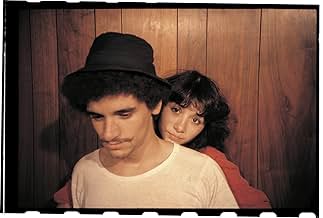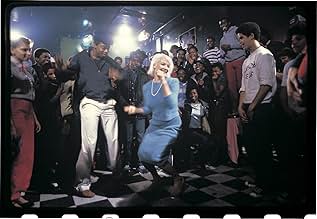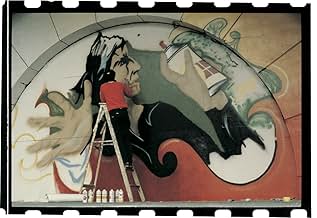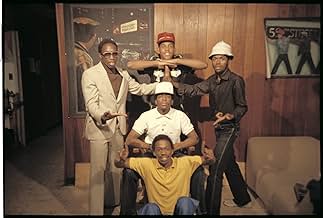IMDb-BEWERTUNG
7,0/10
3102
IHRE BEWERTUNG
Füge eine Handlung in deiner Sprache hinzuSouth Bronx graffiti artist Zoro is commissioned to paint a backdrop for a hip-hop concert.South Bronx graffiti artist Zoro is commissioned to paint a backdrop for a hip-hop concert.South Bronx graffiti artist Zoro is commissioned to paint a backdrop for a hip-hop concert.
Lee Quiñones
- Raymond 'Zoro'
- (as 'Lee' George Quinones)
Lady Pink
- Rose 'Lady Bug'
- (as Sandra 'Pink' Fabara)
Fab 5 Freddy
- 'Phade'
- (as Frederick Braithwaite)
Andrew Witten
- Z-Roc
- (as Zephyr)
William Rice
- Television Producer
- (as Bill Rice)
Daze
- Union Crew
- (as Chris 'Daze' Ellis)
Empfohlene Bewertungen
No true hip-hop head should go without seeing this movie. It is the first and probably the most accurate representation of the early hip-hop scene. IMDB has categorized Wild Style under the genre of documentary. Although the movie has a documentary feel with footage of hip-hop heads in action, it is not a true documentary because it contains a plot line which was scripted.
The plot revolves around the character of Raymond, who is played by the legendary graf artist Lee Quinones. We see what happens to him as his art starts to receive recognition from wealthy art connoisseurs. He has many personal struggles as he deals with this new attention. But it seems that all of his problems are resolved when he is painting a mural for a large hip hop concert and realizes that his art shouldn't always be about him.
There is plenty of footage that represents all four elements of hip hop: the MC, the DJ, the graf artist, and the B-boy. The Double Trouble scene and the basketball rapping scene were recently remade in Sprite commercials (Nas, Kobe Bryant, Tim Duncan, etc.) to appeal to the hip hop crowd. We also see Lee Quinones in action in several scenes as well as footage of Grandmaster Flash. My personal favorite is the footage of a young Rocksteady Crew (Crazy Legs, Prince Ken Swift, Mr. Freeze, Frosty Freeze, etc. I think they're about 14-15?) performing at the concert at the end of the movie. And there are many other memorable scenes.
Although Wild Style is not a true documentary, I think it has preserved the true essence of hip hop during that time for younger people (such as myself) to experience. Truly a must see and a classic.
The plot revolves around the character of Raymond, who is played by the legendary graf artist Lee Quinones. We see what happens to him as his art starts to receive recognition from wealthy art connoisseurs. He has many personal struggles as he deals with this new attention. But it seems that all of his problems are resolved when he is painting a mural for a large hip hop concert and realizes that his art shouldn't always be about him.
There is plenty of footage that represents all four elements of hip hop: the MC, the DJ, the graf artist, and the B-boy. The Double Trouble scene and the basketball rapping scene were recently remade in Sprite commercials (Nas, Kobe Bryant, Tim Duncan, etc.) to appeal to the hip hop crowd. We also see Lee Quinones in action in several scenes as well as footage of Grandmaster Flash. My personal favorite is the footage of a young Rocksteady Crew (Crazy Legs, Prince Ken Swift, Mr. Freeze, Frosty Freeze, etc. I think they're about 14-15?) performing at the concert at the end of the movie. And there are many other memorable scenes.
Although Wild Style is not a true documentary, I think it has preserved the true essence of hip hop during that time for younger people (such as myself) to experience. Truly a must see and a classic.
Legendary New York graffiti artist Lee Quinones plays the part of Zoro, the city's hottest and most elusive graffiti writer. The actual story of the movie concerns the tension between Zoro's passion for his art and his personal life, particularly his strained relationship with fellow artist Rose.
Director Charlie Ahearn was approached by graffiti artist Fred Braithwaite, later known as Fab 5 Freddy, who wanted to make a film about hip-hop (as a broad culture encompassing emceeing, DJing, graffiti and break-dancing) and graffiti as an art form. Braithwaite was an acquaintance of Lee Quiñones, whom Ahearn had long-wanted to film and whose murals he has always admired. Braithwaite brought Quiñones in to meet Ahearn and the three began discussions about creating a hip-hop movie.
As a film, this movie is pretty lacking -- the plot is weak, and the acting is completely awful. But that was never the point. With most of the characters ad libbing their lines and actually being real life hip hop and graffiti artists, this almost serves as a pseudo-documentary. Probably no other film better captures the rise of hip hop than "Wild Style".
Director Charlie Ahearn was approached by graffiti artist Fred Braithwaite, later known as Fab 5 Freddy, who wanted to make a film about hip-hop (as a broad culture encompassing emceeing, DJing, graffiti and break-dancing) and graffiti as an art form. Braithwaite was an acquaintance of Lee Quiñones, whom Ahearn had long-wanted to film and whose murals he has always admired. Braithwaite brought Quiñones in to meet Ahearn and the three began discussions about creating a hip-hop movie.
As a film, this movie is pretty lacking -- the plot is weak, and the acting is completely awful. But that was never the point. With most of the characters ad libbing their lines and actually being real life hip hop and graffiti artists, this almost serves as a pseudo-documentary. Probably no other film better captures the rise of hip hop than "Wild Style".
Much like the later documentary STYLE WARS, this is a portrait of the blossoming New York hip hop scene of the early 80's, encompassing rap, break dancing, and graffiti art. However, this film weaves in a fictional plot line about a tagger (real graffiti artist "Lee" Quinones) struggling with his persona and his art and its place in society. As a film, the word that comes to mind is "amateurish". The cast consists mostly of real personalities from the scene, and none of them are particularly good at acting. The photography is lackluster and the editing is sloppy, and the low budget is obvious (a scene of people frolicking in a pile of money takes on an unintended comic edge when it turns out to be all $1 bills). But as a celebration of artistic expression, it's a joy. If the dramatic scenes aren't exactly Oscar-caliber, they're at least heartfelt, and serve well enough as the glue between the performances, which are electrifying. Featuring Grand Master Flash, Busy Bee, Lisa Lee, Double Trouble, Rock Steady Crew and more, and culminating in a dynamite outdoor amphitheater show, it's a showcase for a lot of great talent. Not the best filmmaking in the world, but a hell of a party.
This film does not have a very good plot or actors, but it is a must see for fans of Hip-Hop. This film shows us what Hip-Hop started out as and what it was meant to be, before it was corrupted by the mainstream media. Hip-Hop in the mid seventies was a form of free expression for the young people living in the boogie down bronx. D.J.'s started looping breaks just like the Selectas in Jamaica, except they were using Disco and Funk singles instead of Reggae and Ska, and the crowds responded to this by doing crazy acrobatic or robotic dance moves. The D.J.'s called these people breakers, breakdancers or b-boys/girls. The kids started forming D.J. and breaker crews and they would tag the names of their crews on the subway trains and alleyways in the Bronx using spraypaint. D.J.'s used to shout out the names of the breakers and crews by saying, "Yo crazy legs is in the house.", they would also brag about themselves on the mic by making up rhymes about themselves. But as the break looping became more artistic and complex to keep the b-boys/girls breaking the D.J.'s had to get someone else to do the rhyming. Thus giving us the emcees or M.C.'s or Master of Ceremonies.
I had heard that Blondie was in this movie, but was disappointed to find that they didn't appear, although two Blondie songs were used as background music (including Rapture). Chris Stein also played synthesized guitar for the soundtrack. This film is very good as a documentary of the early days of old school rap (it's fascinating to see Grandmaster Flash & Busy Bee work) & graffiti (we get to see all the ugly subway train car logos we could ask for, & some of the beautiful wall murals), but in reality, the movie is only a pseudo-documentary. Real graffiti artist Lee Quinones (Lee) plays graffiti man Zoro in the movie, & Fab 5 Freddie tries to hook him up with Manhattan art gallery types. As a movie, the plot is childish, the subplot (Lee & Pink's romance) undeveloped, & the acting is, well, adolescent. As a documentary, I give it 8/10; as a movie, I give it 2/10; overall 5/10.
Wusstest du schon
- WissenswertesThe stick-up guys were cast when Charlie Ahearn saw them hanging around the location. Ahearn offered them a prop gun but they insisted on using their real sawed-off shotgun. All of their lines were improvised.
- PatzerAt 6:18 Hector tells Raymond 'Zoro' to take off his do-rag. Then Ray's hair pops back and forth between being flat from the do-rag to a picked out Afro during their conversation.
- VerbindungenEdited into And You Don't Stop: 30 Years of Hip-Hop (2004)
Top-Auswahl
Melde dich zum Bewerten an und greife auf die Watchlist für personalisierte Empfehlungen zu.
- How long is Wild Style?Powered by Alexa
Details
Box Office
- Weltweiter Bruttoertrag
- 4.948 $
Zu dieser Seite beitragen
Bearbeitung vorschlagen oder fehlenden Inhalt hinzufügen


























